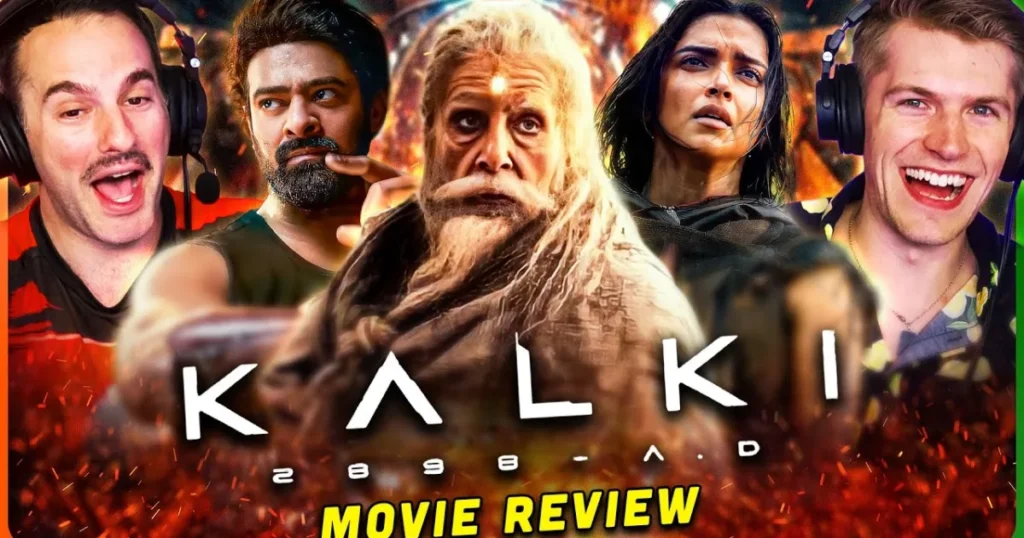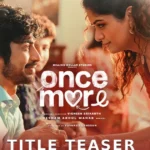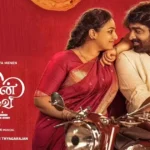“kalki movie review” is not just a film; it’s a bold leap into uncharted territory for Indian cinema, blending ancient mythology with futuristic sci-fi in a way that’s both ambitious and awe-inspiring. Directed by Nag Ashwin, this Telugu-language epic has sparked conversations across the globe, earning praise for its visual grandeur and polarizing opinions for its narrative choices. With a star-studded cast, jaw-dropping visuals, and a hefty budget, does “Kalki 2898 AD” live up to the hype? Let’s dive into this comprehensive review, exploring the plot, performances, technical aspects, audience reactions, box office performance, and more, all while keeping it spoiler-free and engaging.
kalki movie review details table
|
Aspect |
Details |
|---|---|
|
Title |
Kalki 2898 AD |
|
Director |
Nag Ashwin |
|
Cast |
Prabhas, Amitabh Bachchan, Deepika Padukone, Kamal Haasan, Disha Patani |
|
Genre |
Mythological Sci-Fi, Action, Adventure, Drama |
|
Release Date |
June 27, 2024 |
|
Runtime |
3 hours 1 minute |
|
Language |
Telugu (with Tamil, Hindi, Kannada, Malayalam, and English versions) |
|
Budget |
₹600-700 crore (approx. $75-90 million USD) |
|
Box Office |
₹1,180 crore worldwide (as of 50+ days of theatrical run) |
|
IMDb Rating |
7.0/10 (as of September 2025) |
|
Rotten Tomatoes |
77% (based on 39 critics’ reviews, average rating 7.1/10) |
|
Music |
Santhosh Narayanan |
|
Cinematography |
Djordje Stojiljkovic |
|
Production Company |
Vyjayanthi Movies |
Spoiler-Free Plot Summary
Set in the dystopian year of 2898 AD, “kalki movie review” transports viewers to Kasi, the last surviving city on a ravaged Earth. The world is divided between the downtrodden masses living in a desolate slum and the elite residing in the towering, futuristic Complex—a floating megastructure ruled by the enigmatic Supreme Yaskin (Kamal Haasan). The story weaves together ancient Hindu mythology, particularly the Mahabharata, with a sci-fi narrative, centering on a prophesied savior, Kalki, the final avatar of Lord Vishnu.
The plot follows Bhairava (Prabhas), a charismatic bounty hunter with dreams of ascending to the Complex, and Ashwatthama (Amitabh Bachchan), an ancient warrior cursed with immortality, tasked with protecting a sacred unborn child. Their paths cross with Sumathi (Deepika Padukone), a pregnant woman whose child holds the key to humanity’s salvation. As they navigate a treacherous wasteland, pursued by Yaskin’s forces, the story unfolds through high-stakes chases, epic battles, and revelations that tie the past to the future.
The narrative spans millennia, starting with a prologue set in 3102 BC during the Kurukshetra War, and builds toward a climactic showdown that sets the stage for the Kalki Cinematic Universe. It’s a tale of destiny, redemption, and hope, layered with mythological references and futuristic stakes, making it a unique cinematic experience.
Cast and Performances
Prabhas as Bhairava
Prabhas, the Baahubali star, brings his signature charisma to Bhairava, a roguish bounty hunter with a blend of humor and bravado. His performance shines in action sequences and comedic moments, particularly in the first half, where his larger-than-life persona carries the film. However, some critics note that his character feels underwritten in parts, with the screenplay not fully capitalizing on his star power until the second half. Fans, however, praise his screen presence, especially in the climactic scenes that reveal deeper layers to Bhairava.
Amitabh Bachchan as Ashwatthama
Amitabh Bachchan steals the show as the towering, immortal warrior Ashwatthama. At nearly eight feet tall (achieved through VFX and prosthetics), Bachchan’s commanding presence and emotional depth make him the heart of the film. His action sequences are breathtaking, and his dialogue delivery resonates with gravitas, earning him widespread acclaim as the standout performer. Critics and audiences alike hail his portrayal as a masterclass in balancing intensity and vulnerability.
Deepika Padukone as Sumathi
Deepika Padukone delivers a nuanced performance as Sumathi, the pregnant woman central to the story. Her role is largely silent, relying on expressive eyes and subtle gestures to convey fear, hope, and determination. While some feel her character lacks agency due to the screenplay’s focus on action, others praise her for bringing emotional weight to a pivotal role. Her chemistry with Bachchan is a highlight, though her limited screen time leaves audiences wanting more.
Kamal Haasan as Supreme Yaskin
Kamal Haasan’s portrayal of the god-king Yaskin is chilling yet underutilized. With limited screen time, he still manages to exude menace and authority, particularly in the second half. Critics note that his role feels more like a teaser for the sequel, with his full potential yet to be explored. Nevertheless, his presence adds gravitas to the film’s dystopian world.
Disha Patani as Roxie
Disha Patani’s Roxie is a glamorous but poorly written character, serving as a narrative device to introduce Bhairava to the Complex. Her performance is adequate but lacks depth, with critics pointing out that her romantic subplot with Prabhas feels forced and detracts from the main story.
Supporting Cast and Cameos
The film is peppered with cameos from stars like Vijay Deverakonda, Dulquer Salmaan, and Mrunal Thakur, adding excitement for fans but occasionally feeling like fan service. Supporting actors like Shobhana and Saswata Chatterjee deliver solid performances, with Shobhana’s saintly Mariam and Chatterjee’s Commander Manas adding depth to the world. However, some cameos, like those of Brahmanandam, feel out of place and disrupt the narrative flow.
Direction by Nag Ashwin
Nag Ashwin, known for “Mahanati,” takes a monumental risk with “kalki movie review,” blending mythology and sci-fi in a way Indian cinema has rarely attempted. His vision is ambitious, creating three distinct worlds—Kasi, Shambhala, and the Complex—each with its own visual and thematic identity. Ashwin’s direction shines in the second half, where the narrative converges, and the mythological stakes elevate the action. However, his inexperience with large-scale action films shows in the uneven pacing of the first half, which some critics describe as a “laborious setup.” Despite this, his ability to weave Hindu scriptures into a futuristic narrative is commendable, making the film a bold step forward for Telugu cinema.
Screenplay Analysis
The screenplay, penned by Nag Ashwin with additional contributions from Rutham Samar and Sai Madhav Burra, is both a strength and a weakness. The fusion of Mahabharata lore with dystopian sci-fi is innovative, but the first half struggles with flat pacing and excessive world-building. Some subplots, like Bhairava’s romance with Roxie, feel like distractions, while the comedy (e.g., Brahmanandam’s scenes) often jars with the film’s tone. The second half redeems these flaws, delivering a taut, emotionally charged narrative with a thrilling climax that ties up loose ends while setting up the sequel. Critics note that tighter editing could have made the three-hour runtime more engaging.
Cinematography
Djordje Stojiljkovic’s cinematography is a visual triumph, painting a brooding dystopian world with muddy browns, ominous blacks, and fleeting glimpses of sunlight. The camera work in action sequences, particularly the chase scenes, is dynamic, with innovative angles that immerse viewers in the chaos. The Kurukshetra war prologue and the futuristic cityscapes of Kasi and the Complex are visually stunning, rivaling Hollywood blockbusters. However, some scenes suffer from overzealous CGI, particularly in de-aging effects for Bachchan, which occasionally distract from the narrative.
Music and Background Score
Santhosh Narayanan’s background score is a standout, amplifying the film’s epic scope with pulsating rhythms and haunting melodies. The score elevates action sequences and adds emotional weight to key moments, though some feel it could have been used more consistently. The songs, however, are a weak link, with none being particularly memorable and some feeling like unnecessary padding. The eclectic soundtrack, blending Punjabi beats, Western classical, and Indian influences, adds to the film’s chaotic charm but lacks cohesion.
Visual Effects (VFX)
With a budget of ₹600-700 crore, “Kalki 2898 AD” sets a new benchmark for VFX in Indian cinema. The work by DNEG and The Embassy creates immersive worlds, from the desert wasteland of Kasi to the futuristic Complex and the mystical Shambhala. The VFX in action sequences, such as Ashwatthama’s battles and Bhairava’s high-speed chases, are Hollywood-caliber, earning praise for their crispness and scale. However, some shots, particularly de-aged CGI, falter, and the film’s heavy reliance on VFX occasionally overshadows character development. Despite these minor flaws, the visuals are a proud moment for Indian cinema.
Strengths
-
Ambitious Vision: Nag Ashwin’s blend of Mahabharata mythology and sci-fi is groundbreaking, offering a fresh narrative for Indian audiences.
-
Amitabh Bachchan’s Performance: Bachchan’s towering presence and emotional depth make Ashwatthama the film’s soul.
-
Stunning VFX and Cinematography: The visual spectacle rivals global standards, with meticulously crafted worlds and action sequences.
-
Second Half and Climax: The narrative picks up post-interval, delivering thrilling action and mythological revelations that leave audiences eager for the sequel.
-
Cultural Resonance: The film’s roots in Hindu scriptures add depth, making it a unique sci-fi epic with universal themes of hope and redemption.
Weaknesses
-
Uneven Pacing: The first half drags with excessive world-building and misplaced comedic elements, testing audience patience.
-
Underwritten Characters: Characters like Roxie and even Yaskin feel underdeveloped, with limited screen time or narrative purpose.
-
Weak Soundtrack: The songs fail to leave an impact and disrupt the film’s flow.
-
Overreliance on Hollywood Tropes: Borrowings from “Dune,” “Star Wars,” and “Mad Max” give a sense of déjà vu for seasoned viewers.
-
Lengthy Runtime: At over three hours, tighter editing could have enhanced the film’s impact.
Audience and Critics’ Reactions
Audience Reactions
“Kalki 2898 AD” has polarized audiences, with fans praising its scale and ambition while others criticize its pacing. On platforms like Reddit, viewers laud the second half’s action and Bachchan’s performance but express frustration with the slow first half and Prabhas’ underutilized role. Social media buzz highlights the film’s visuals and cameos, with posts like, “Last 45 minutes gave me goosebumps!” and “Amitabh Bachchan is unreal!” However, some fans feel the film prioritizes spectacle over emotional depth, with one user noting, “It’s a visual feast but lacks heart in parts.”
Critics’ Reactions
Critics have given mixed-to-positive reviews, with Rotten Tomatoes reporting a 77% approval rating. Sukanya Verma of Rediff gave 3.5/5 stars, praising Bachchan’s “indefatigable energy” and the film’s mythological integration. The Times of India rated it 3/5, commending the visuals but noting a “flat screenplay.” Variety called it a “wildly uneven mashup” but appreciated its ambition, while The Guardian described it as a “fizzy Telugu-language mashup” that’s “mostly a hoot.” Some critics, like those from WION, felt it “failed to impress” due to its derivative nature, but most agree it’s a bold step for Indian cinema.
Box Office Buzz
“Kalki 2898 AD” has been a box office juggernaut, grossing ₹1,180 crore worldwide against a ₹600 crore budget, making it the fourth highest-grossing Indian film ever. It earned ₹149.3 crore in India over its opening weekend and debuted third globally, behind “Inside Out 2” and “A Quiet Place: Day One.” The film’s international appeal, driven by its star cast and high production values, has made it a pan-Indian hit, with strong performances in North America and urban markets. Its 50-day theatrical run underscores its commercial success, though some note it may not resonate as strongly in smaller towns.
Comparisons to Other Films
“kalki movie review” invites comparisons to Hollywood epics like “Dune,” “Star Wars,” and “Mad Max: Fury Road” due to its dystopian setting and visual style. Critics note similarities to “Brahmastra” for its mythological roots, but “Kalki” is seen as more ambitious in scope. Unlike “RRR,” which balanced action and emotion seamlessly, “Kalki” struggles with emotional connect but excels in visual spectacle. Compared to “Adipurush,” it avoids the pitfalls of poor VFX and execution, delivering a more polished experience. However, its derivative elements make it less original than “RRR” or “Baahubali.”
Final Verdict and Star Rating
“kalki movie review” is a monumental achievement in Indian cinema, pushing boundaries with its blend of mythology and sci-fi. While it stumbles with uneven pacing, a bloated runtime, and underdeveloped characters, its strengths—stunning visuals, Amitabh Bachchan’s powerhouse performance, and a gripping second half—make it a must-watch for fans of epic cinema. Nag Ashwin’s vision lays a promising foundation for the Kalki Cinematic Universe, leaving audiences eager for the sequel. It’s not flawless, but its ambition and execution make it a game-changer.






